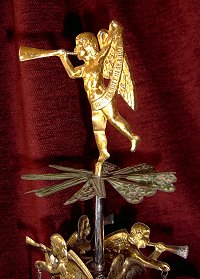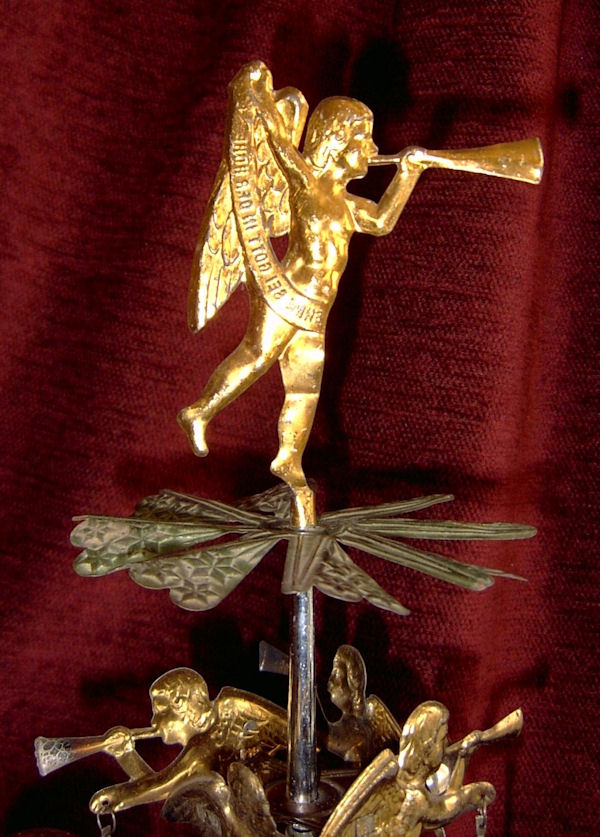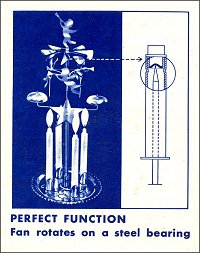
"Swedish-Pattern" Angel Chimes
Before World War II, most candle chimes were made in Germany of lithographed and/or polished tin, exhibiting — like
other tin toys of the period — a wealth of pictorial and/or embossed
detail, and many moving parts. World War II killed both the export
and German domestic markets for candle chimes and other tin toys for
the duration, and for a significant period thereafter. At the same
time, it is likely that the Adrian & Stock design patents,
originally established in 1905, had by this time expired. Whatever
the specific impetus, it is clear that Swedish and
other northern European makers arose to meet a continuing
post-war demand for candle chimes, which Germany, at least
initially, could not fulfill. These later makers took the opportunity to
impose their own aesthetic. Post-War chimes involved somewhat
fewer pieces than their Pre-War cousins, were simpler in
outline and detail, and were generally stamped from unadorned flat
brass, rather than embossed lithographed tin.
 In the postwar years, aggressive marketing
of simple, well-designed and carefully-engineered “Swedish pattern”
candle chimes through Sears (an example from the 1958 Sears "Wish
Book" is shown at right) and other American outlets led to a
significant rise in popularity of these toys, despite the
simultaneous explosive increase in the sales of electric Christmas
lighting. Despite the claim to derive from “a beautiful
old Swedish original,” almost every important feature of these
modern Swedish pattern angel chimes derives from German models —
particularly those of Adrian & Stock — of the early 20th century. In the postwar years, aggressive marketing
of simple, well-designed and carefully-engineered “Swedish pattern”
candle chimes through Sears (an example from the 1958 Sears "Wish
Book" is shown at right) and other American outlets led to a
significant rise in popularity of these toys, despite the
simultaneous explosive increase in the sales of electric Christmas
lighting. Despite the claim to derive from “a beautiful
old Swedish original,” almost every important feature of these
modern Swedish pattern angel chimes derives from German models —
particularly those of Adrian & Stock — of the early 20th century.
The family resemblance is striking, particularly in the “floating
angels” with their bell-clappers, and distinctive pompadour hairdos.
Below is a sequence of images showing how the Adrian & Stock "Engelsgeläut"
evolved into the modern "Angel Chime." From left to right, 1) Adrian
& Stock "Engel-Weihnachts-Geläut
of 1905; 2) Adrian & Stock "Engelsgeläut" from the 1920s; 3)
Swedish-made “Änglaspelet” from the 1940s; Swedish-made "Angel
Chime" marketed by US firms in the 1950s and 1960s.
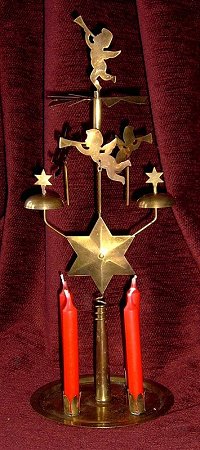
“Änglaspelet”
(Angel Carillon)
(34.5. x 13.5 cm., base = 13 cm. dia.)
This very
early post-WWII Swedish “Änglaspelet” forms an interesting link
between the Stock designs of the early 20th century and today’s
Swedish pattern angel chimes. The box includes directions for
assembly in both English and Swedish. Although the
plain base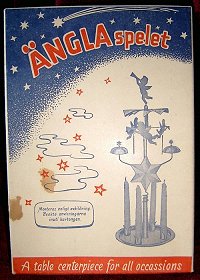 design and die-cut angels, as well as the exclusive use
of brass, mark it as a Swedish-derived product, most of the key
design elements — the spiral “spring” support, the central star, the
shape of the bell supports, the tiny stars atop the chimes — are
obviously adapted from pre-war Adrian & Stock designs: compare this
post-war chime, element by element, with a “No. 3” Adrian & Stock
chime from the 1930s. design and die-cut angels, as well as the exclusive use
of brass, mark it as a Swedish-derived product, most of the key
design elements — the spiral “spring” support, the central star, the
shape of the bell supports, the tiny stars atop the chimes — are
obviously adapted from pre-war Adrian & Stock designs: compare this
post-war chime, element by element, with a “No. 3” Adrian & Stock
chime from the 1930s.
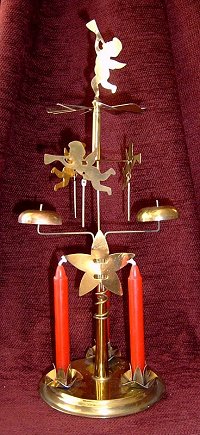
Holt
Howard “Angel-abra”
(33 x 14.5 cm., base = 11.5 cm. dia.)
Another early
transitional design, similar to the modern Swedish pattern in most
respects. Holt Howard Associates were based in New York City, but it
is not clear whether this chime was produced in the U.S., or
imported from overseas. The instructions include a charming (but
highly unlikely) story on the origins of the “Angel-abra” chime.
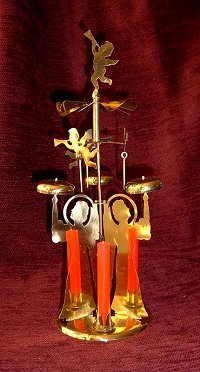
Sudhouse
“Weihnachts Glockenspiel”
(Christmas Carillon)
(33 x 13.5 cm., base = 11 cm. dia.)
Elements of
the very popular post-war Swedish chimes were sometimes copied (or
perhaps “repatriated” is a better word) by German manufacturers.
Dating to the 1950s, this “Weihnachts Glockenspiel” by the West
German firm of Sudhouse has a unique patented base with a trio of
chime-bearing angels, but its superstructure of “floating” cherubs
is identical to contemporary Swedish models.
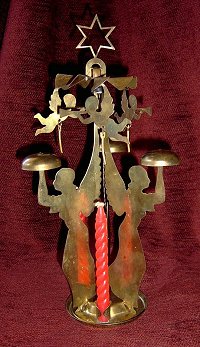
Dansk-Svensk Metalkunst
“Engle Spil” (Angel Bells)
An interesting
variant of the preceding chime, featuring a more-or-less direct
imitation of Sudhouse's distinctive trio of chime-bearing angels,
but with a unique superstructure of rather bizarre cherubs, and a
six-pointed star as a topper. The box indicates that the "Engle Spil" was made in Denmark
for export to English speaking countries.
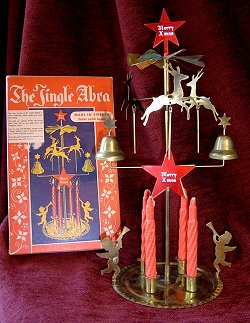
“Jingle
Abra”
(32 x 17 cm., base = 13 cm. dia.)
This imported
“Jingle Abra” is by far the most elaborate post-war Swedish pattern
chime this collector has seen. Lithographed red stars, a small herd
of reindeer, and a flanking pair of trumpeting angels harkens back
to the complicated Adrian & Stock designs of the 1930s, a refreshing
departure from the relatively austere designs of the post-war era.
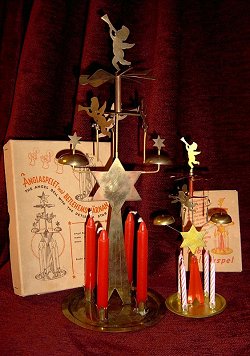
"Änglaspelet
med
Betlehemstjärnen"
(Angel
Bell with Bethlehem Star)
"Baby Klockspel"
Shown with their boxes,
here are two early post-WWII variants of a "Swedish-pattern" chime,
one full size, and one in miniature. the smaller version
requiring birthday candles instead of the standard
4-inch variety.
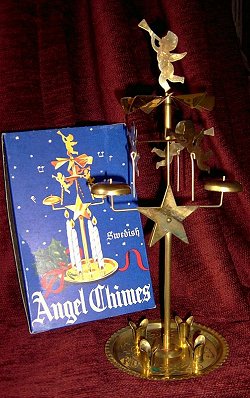
Avebe
“Angel Chimes”
(30 x 13.5 cm., base = 12 cm. dia.)
Avebe “Giant Angel Chimes”
(43 x 20 cm., base = 18 cm. dia.)
“Christmas Tree” chimes
(27 x 14 cm., base = 12.5 cm. dia.)
Shown are some
sets of typical angel chimes in this pattern dating from the 1960s
and 1970s. In addition to the standard angel chime (left), this particular manufacturer (Avebe
of Sweden) also offered a “giant” angel chimes (below
left), as well as a design variant which featured a
Christmas tree as a base, and a star topper (below
right).
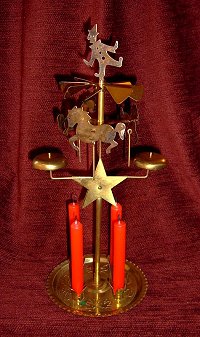
Avebe
“Angel-Party Chimes”
(30 x 13.5 cm., base = 12 cm. dia.)
“Angel Chimes” with music box
(33 x 14 cm., base = 4 cm. high x 9.5
cm. dia.)
Some sets
of Swedish-pattern chimes also came packaged with an additional suite of figures — horses and
clowns, instead of angels — which allowed the chimes to be used as a
party or birthday centerpiece. Music boxes were added to the base of
some models; the one shown below plays “Happy Birthday to You,” but a variant
which plays “Silent Night” has also been noted. For some reason it
is rare to find any of the music-box chimes in their original
packaging.
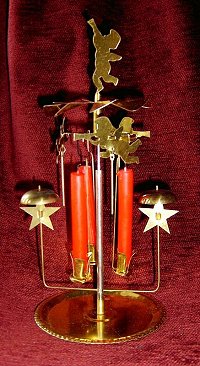
Dan-Dee
Imports “Angel Chimes with Spinning Candles”
(27 x 14 cm., base = 12 cm. dia.)
These days many “Swedish pattern” angel chimes are
made in China or Japan, producing some
strange and interesting variants on the basic design. This one, a
personal favorite,
features candle-holders attached to the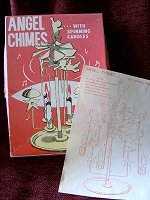 impeller, so that the
candles spin along with the angels. I haven’t been able to make it
work, and I’m not convinced that the laws of physics will
allow it: like trying to power a sailboat with an onboard electric fan ... impeller, so that the
candles spin along with the angels. I haven’t been able to make it
work, and I’m not convinced that the laws of physics will
allow it: like trying to power a sailboat with an onboard electric fan ...
|
